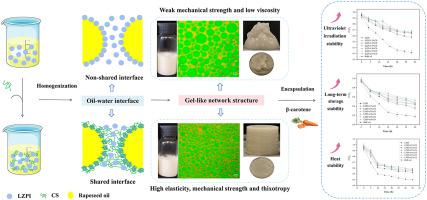Food Hydrocolloids ( IF 11.0 ) Pub Date : 2022-09-10 , DOI: 10.1016/j.foodhyd.2022.108133 Qiaoli Zhao , Liuping Fan , Yuanfa Liu , Jinwei Li

|
In this study, the feasibility of the mayonnaise-like high internal phase Pickering emulsions (HIPPEs) prepared by phosphorylated perilla protein isolate-chitosan composite nanoparticles (LZPI-CS CNPs) as three-dimensional (3D) printing inks and lipid-soluble β-carotene delivery vehicles was explored. The spherical LZPI-CS CNPs (232–336 nm in particle size) were formed by hydrogen bonds and electrostatic interaction, which exhibited improved wettability and superior capacity to reduce interfacial tension and enhance the viscoelasticity of the interfacial film even at low chitosan (CS) concentration. The rigid and dense interfacial architecture formed by LZPI-CS CNPs provided steric barrier and strong electrostatic repulsion, preventing droplets from coalescence during long-term storage, centrifugation and heat treatment. The incorporation of CS also obviously reduced the adsorption percentage of phosphorylated perilla protein isolate (LZPI) at the oil-water interface (from 87.27% to 83.15%), and caused the changes of its secondary structure and tertiary conformation. More interestingly, increasing the CS concentration (0.1–0.6 wt%) in LZPI-CS CNPs led to a progressive strengthening of viscosity, viscoelasticity and thixotropy-recovery capacity of HIPPEs, allowing their controllable injectability and printability during 3D printing. The HIPPEs prepared by LZPI-CS CNPs containing 0.6 wt% CS exhibited the most favorable shape fidelity, printing resolution and clear outline. Additionally, the stability of β-carotene against different environmental stresses was also significantly enhanced after encapsulation with HIPPEs. These findings demonstrated that the complexation of LZPI and CS could provide an effective strategy to construct mayonnaise-like HIPPEs as 3D printing inks and delivery vehicles of hydrophobic bioactive components.
中文翻译:

蛋黄酱类高内相 Pickering 乳液由共组装的磷酸化紫苏蛋白分离物和壳聚糖稳定,用于挤出 3D 打印应用
在这项研究中,以磷酸化紫苏分离蛋白-壳聚糖复合纳米粒子(LZPI-CS CNPs)制备的蛋黄酱样高内相Pickering乳液(HIPPEs)作为三维(3D)印刷油墨和脂溶性β-探索了胡萝卜素输送载体。球形 LZPI-CS CNPs(粒径为 232-336 nm)是由氢键和静电相互作用形成的,即使在低壳聚糖(CS)下也表现出改善的润湿性和降低界面张力和增强界面膜粘弹性的能力专注。LZPI-CS CNPs形成的刚性和致密界面结构提供了空间屏障和强静电排斥,防止液滴在长期储存、离心和热处理过程中聚结。CS的加入也明显降低了磷酸化紫苏分离蛋白(LZPI)在油水界面的吸附率(从87.27%降低到83.15%),并导致其二级结构和三级构象发生变化。更有趣的是,增加 LZPI-CS CNP 中的 CS 浓度(0.1-0.6 wt%)导致 HIPPE 的粘度、粘弹性和触变性恢复能力逐渐增强,从而使其在 3D 打印过程中具有可控的可注射性和可打印性。由含有 0.6 wt% CS 的 LZPI-CS CNPs 制备的 HIPPEs 表现出最有利的形状保真度、印刷分辨率和清晰的轮廓。此外,用 HIPPE 包封后,β-胡萝卜素对不同环境胁迫的稳定性也显着增强。













































 京公网安备 11010802027423号
京公网安备 11010802027423号